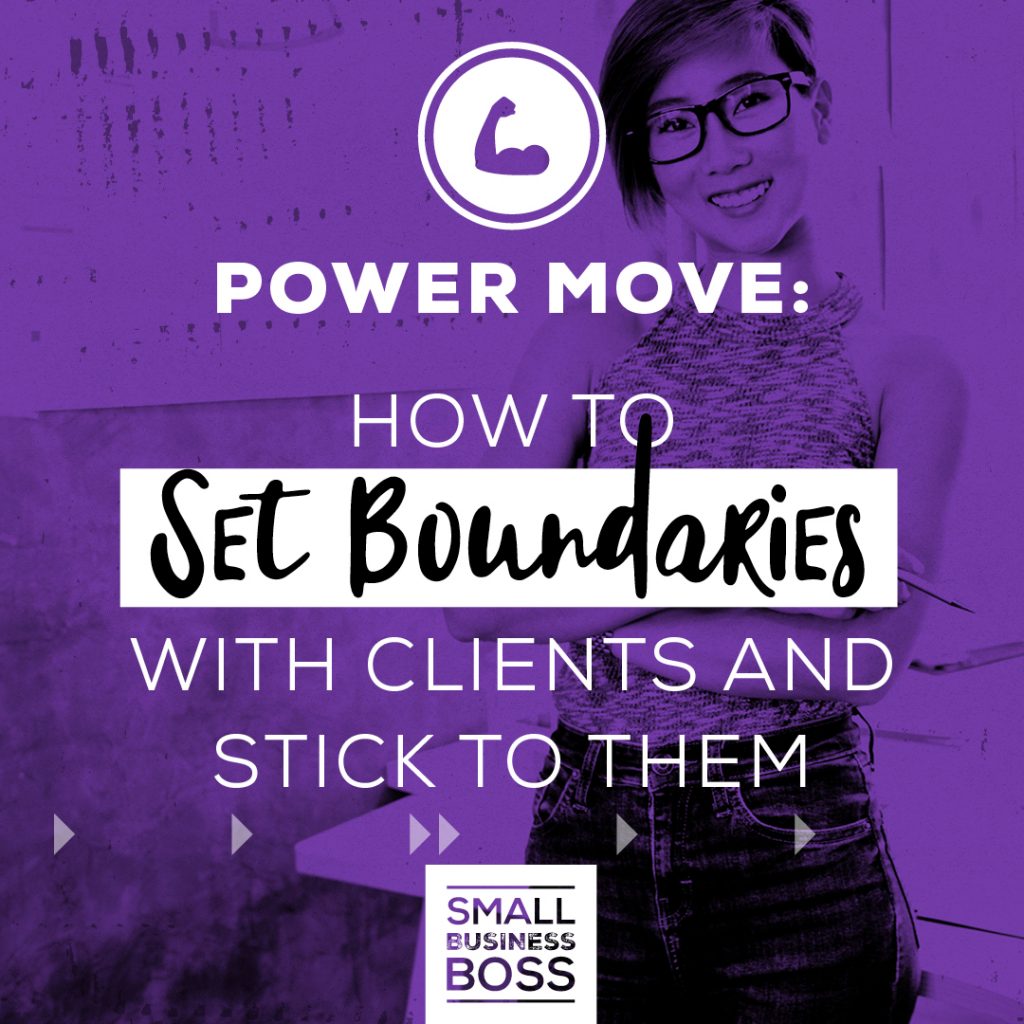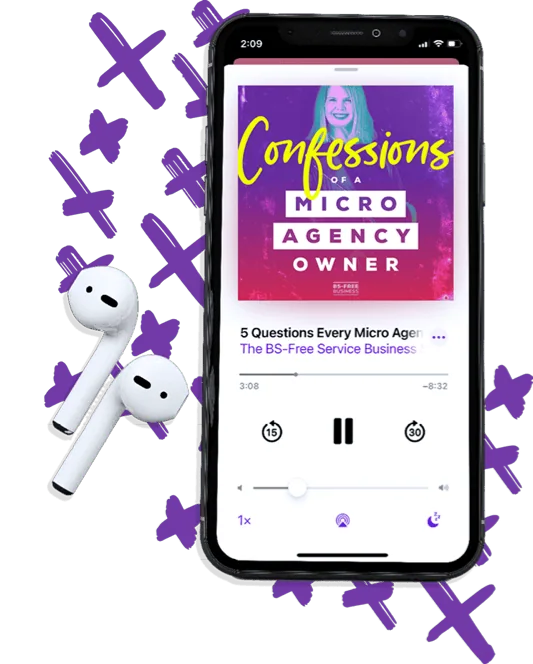
Search the site:
Episode 149: Power Move: How to Set Boundaries with Clients and Stick to Them
If there’s one thing that’s tough for most service business owners, it’s setting boundaries with our clients and sticking to them. In this episode, I’m unpacking how to set boundaries along with how to manage them when they’re put to the test.
Boundaries tend to be a hot topic in most of the communities I’ve been involved in — and with good reason because they’re challenging to manage. Many times when this conversation comes up, it’s because a client has crossed the line. I know —I’ve been there — with a client pushing and pushing, and then I want to snap as they’ve gone too far.
What I’ve had to learn is that I had a role to play in those situations, as to hold boundaries, you need to establish them in advance. You need to be clear on how things work and communicate with your clients in a consistent way.
What I’m not talking about are those nightmare clients that go too far. You know, clients from hell who just won’t quit. What I am talking about are the ongoing situations that you find yourself in time and time again. The things that trigger you or push your buttons and they just seem to keep happening.
Start by Understanding Your Role
The key with boundaries is realizing that you have a choice, and with clients, you need to take the lead. I know in the past, I’d get really upset or ticked off at a situation, and then I’d realize I was actually complicit.
Yes, that’s tough to admit, and it takes a real boss to own up to it, but you need to unpack that a bit, so you’re able to have boundaries in place and hold them.
I know you’re running a service business, but that doesn’t mean you need to be a doormat. You can be of service and have reasonable client expectations, clear deadlines, and a strong working relationship.
Being Flexible Within Reason
An important part of being of service is being flexible and willing to work with your clients to some degree.
I’ve definitely had experience with people where I was the client and they were so rigid — and at times ridiculous with their boundaries — that it made me question if they valued me as a client. You don’t want to be like that and have your clients questioning your commitment.
Honestly, this is rare, but I did want to bring it up so you know how boundaries can go too far. There are healthy boundaries, and then there are ones that don’t allow you to be helpful to your clients.
On the flip side, you don’t need to available 24/7/365 for your clients either.
You want to have clear expectations for how you’ll work together so you can hold those boundaries. You need to spell out for your clients what your office hours are, how to communicate with you, when you give updates and more.
Most of all, once those are established, you need to stick to them. If you’re always being flexible, you’re telling your clients those expectations don’t apply.
Dealing with Client Requests
If a client is asking for something that’s out of the ordinary, assess that request based on the situation. Are they a good client who’s always respectful? Then you potentially can find a way to make things work for both of you.
I like to set boundaries that are hard limits for clients and then leave a little wiggle room. Having that fluidity means we can be seen as going “above and beyond” when really we’re doing what we’re comfortable doing. That helps create strong working relationships and makes clients feel like they matter.
However, let’s say you have a client who is ALWAYS asking for work that’s out of scope, quick turnaround times, work on the weekend and so on — you need to put a stop to it. In my experience, this happens because we signaled to them that this is okay.
Start by reiterating to them your turnaround times, office hours, deadlines and so on. Then you need to stick to them. If your client likes to email on the weekend, don’t answer them until Monday. Just because they’re working, doesn’t mean you need to if that’s not your schedule or agreement with them.
Remember, you get to decide. You are literally the boss, and you don’t have to settle or suck it up. You need to be willing to put your foot down and hold your ground. If a client can’t respect that, it’s a signal they’re probably not a great client for you to be working with.
Establishing How You Work Together
When you run a service business, it’s up to you to set the pace for HOW you work with clients. Those early stages of a client relationship set out how you’ll work together in the future.
That’s why I’ve made a practice of including these details in our proposals. It spells out how we work together — and more importantly — it puts the client at ease as they know what to expect by choosing our team.
At first, I was a bit worried about this, but this section of the proposal is something I can easily refer to if need be. It tells the client you’re running a serious business and that you have office hours and systems for how you do things.
The fact is: You can’t assume your client knows the expectations if you are not clear of what they are. Otherwise, your client will do whatever works for them, so you need to be the one in control.
Keep in mind that you’re not an employee. You’re a contractor. You set your hours of work. Your vacation schedule. How/when you communicate.
Speaking of communication, one of the easiest ways to ensure you have boundaries and that these issues don’t come up with clients is to have a consistent plan for communicating with your clients. If they don’t know what’s going on, it’s easy for them to get nervous or weird about things and start pushing boundaries.
Also, if you’ve had some issues with client boundaries, take some time and figure out what your triggers are. Everyone is different, and something that’s cool with me is really annoying to someone else.
I personally will do anything and everything possible to be proactive with a client and communicate with them in a timely manner as I don’t like when a client nags. It makes me nuts, so I want to stop it before it starts.
I could go on, but you get the point. Know what sets you off and then do what you can to set and manage expectations so it’s not an issue.
Links for the Show:

I’m Maggie Patterson (she/her), and services businesses are my business.
I have 20+ years of experience with client services, am a consultant for agency owners, creatives, and consultants, and vocal advocate for humane business practices rooted in empathy, respect, and trust.
Read or Listen to the Latest
For Solo Business Owners

Growing a solo service business is tough.
It’s even harder when you’re bombarded with BS advice that steers you away from your values and why you started your business in the first place.
This is the podcast for solo creatives and consultants who want to remain as a team of one and have zero interest in the hustle and grind of typical business teachings.
Subscribe now and never miss an episode.
For Micro Agency Owners
Most podcasts for agency owners obsess over revenue growth as the ultimate success metric.

But here’s the truth: not everyone wants to make millions. Your goal might be to build a sustainable business that lets you have a life and doesn’t run you into the ground.
Join me as I spill my shameless confessions and share everything I’ve learned about building a micro agency that skips the BS of tired and typical agency teachings.
Follow Now on All Major Podcast Platforms








